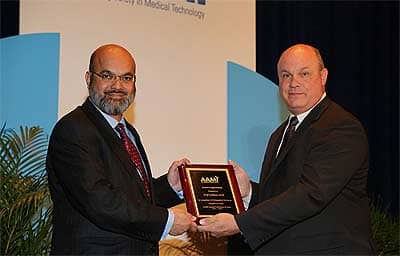In a field without mandatory credentials, certification takes on different meanings for technicians, leaders, and employers.
By Lindsey Nolen
In healthcare technology management (HTM), where technical expertise directly impacts patient safety, certification offers more than just a line on a résumé. Credentials such as the certified biomedical equipment technician (CBET) and certified healthcare technology manager (CHTM)—along with health IT-focused certifications like those from the Healthcare Information and Management Systems Society (HIMSS)—signal credibility, dedication, and a commitment to professional standards.
Yet unlike other healthcare and technical fields, certification in HTM is voluntary. That raises a pressing question: Is it worth the investment?
For many, the answer depends on career goals and timing. While certification is not required to succeed, it often helps professionals advance, strengthen their standing in the field, and differentiate themselves in competitive job markets.
Certification as an Early Career Differentiator
For those at the start of their careers, certification validates foundational knowledge and can be valuable for opening doors to employers when on-the-job experience is limited.
Danielle McGeary, CHTM, PMP, vice president of HTM at AAMI, notes that certifications administered through the AAMI Certification Institute (ACI) are recognized as a mark of competence. She believes the act of seeking certification sends a powerful message. “Pursuing certification shows employers that you’ve taken the initiative to set yourself apart from your peers and demonstrates your commitment to continuous professional growth,” says McGeary.
In 2020, AAMI launched the certified associate in biomedical technology (CABT) credential to give those just entering the field a pathway to certification earlier. Unlike the CBET, which requires either a degree and work experience or four years of professional experience, the CABT can be earned immediately—even by high school students who know they want to pursue HTM.
McGeary says that the program not only allows newcomers to list an AAMI certification on their resume from the start but also inspires them to stay certified throughout their careers. “We find that people who get certified early in their career are more apt to stay certified throughout their career. Plus, it creates a robust workforce,” she says. AAMI introduced a companion training program, BMET 101, as a study guide for the CABT.
Binseng Wang, consultant at BSI – Health Technology Consulting, says earning a certification can provide reassurance to those just starting out. “Certification is a way to reassure oneself that he or she has the basic knowledge. It is valuable for beginners and young professionals to feel more confident,” Wang says.
Certification for Professional Growth
Certification can serve a different purpose for those already established in their HTM careers. Rather than opening doors, it can reinforce credibility, broaden leadership opportunities, and signal ongoing dedication to the profession.
Ted Lucidi, CBET, director of commercial operations and business analytics at Innovatus Imaging, pursued certification in 1990 as a personal benchmark. He viewed it as “a commitment to oneself and the HTM industry,” stating, “I never expected any special consideration from my management team or a faster advancement than my non-certified colleagues.”
Lucidi says the certification helped solidify his knowledge of standards and requirements in healthcare facilities and with medical devices in general.
ACI’s CBET and CHTM credentials cover distinct but complementary areas of expertise. CBET focuses on clinical technology, while CHTM is designed for those in or moving into leadership positions. Chace Torres, CBET, CHTM, Dallas-Fort Worth branch manager at SPBS Inc, who earned both certifications, found they strengthened his credibility. “When I speak in meetings, advocate for my team, or handle regulatory audits, those certs back me up,” he says, adding, “They say, ‘This guy takes the profession seriously.’”
Torres says certification can clarify concepts that professionals might use every day but never formalize through structured study. He also sees it as a way to strengthen individual performance rather than compete with peers. “CBET doesn’t make you better than the next tech,” he says. “It makes you better for the work.”
Certification as a Hiring Signal
Beyond individual career development, certifications also play an important role in how health systems evaluate and select candidates. Mara Daiker, senior director of professional development at HIMSS, says certifications help professionals stand out in competitive environments—especially when their experience spans clinical, operational, and technical domains.
“Health systems are increasingly using certifications to validate skills, especially when candidates come from diverse academic or career backgrounds,” says Daiker.
Industry data supports that trend. According to CompTIA’s Workforce and Learning Trends 2023, about 80% of human resources professionals at medium-to-large firms rely on certifications during the hiring process.1 “Certified candidates stand out in application pools, especially as more roles use skills-based screening systems,” adds Daiker.
Torres champions certification as a strategic career move. “My approach has always been the same: Knock out the credentials before they become the reason you didn’t get the job,” Torres says.
Lucidi notes that Innovatus Imaging doesn’t require certification for its specialized repair teams, but he says credentials can tip the scales when hiring. When two candidates are otherwise equal, he says credentials can be the deciding factor.
What It Takes to Get Certified
HTM professionals have multiple certification pathways, each designed to validate different sets of skills. The most recognized come through ACI and HIMSS.
ACI Certifications
ACI administers credentials such as the CBET, CHTM, and Certified Radiology Equipment Specialist (CRES). Among these, CBET is the most widely recognized, with about 25% to 30% of HTM professionals holding the credential. The exam, offered twice a year, includes 165 questions across six domains—from healthcare technology problem solving to IT and anatomy and physiology. The pass rate hovers around 60%.2
To maintain certification, professionals must earn 30 continuing education units (CEUs) every three years, with 4.5 CEUs automatically granted for full-time work. Remaining credits can be earned through training, volunteering, publishing, or additional certifications. The exam costs between $350 and $550. AAMI provides support resources such as exam outlines, online courses, and practice tests.
Exams are periodically updated to reflect the evolving scope of HTM. Recent revisions to CBET and CRES placed greater weight on IT content, recognizing the growing connectivity and complexity of medical devices.
HIMSS Certifications
HIMSS certifications emphasize healthcare IT, informatics, and digital transformation—areas increasingly central to HTM roles. HIMSS exams are offered at Pearson VUE Testing Centers, through remote proctoring, and at select HIMSS events. Results are provided immediately after testing.
The organization offers three certificates:
- CAHIMS (certified associate in healthcare information and management systems): For early-career professionals or those transitioning into healthcare IT. Eligibility requires a high school diploma plus either 45 hours of continuing education or 150 hours of IT/healthcare experience, or a college degree with reduced requirements. The exam consists of 115 multiple-choice questions (100 scored).
- CPHIMS (certified professional in healthcare information and management systems): Designed for mid-career professionals. Eligibility requires at least a bachelor’s degree plus five years of IT/management systems experience (three in healthcare), or a graduate degree plus three years (two in healthcare), or 10 years of experience (eight in healthcare). The exam includes 115 multiple-choice questions (100 scored).
- CPDHTS (certified professional in digital health transformation strategy): Geared toward senior leaders in digital health. Eligibility includes a bachelor’s degree plus five years of IT/management systems experience (three in healthcare), a graduate degree plus three years (two in healthcare), or 10 years of experience (eight in healthcare). The exam has 100 multiple-choice questions.
Complementary Pathways
ACI and HIMSS certifications give HTM professionals multiple ways to validate expertise.
For many, the choice comes down to career direction. Those focused on equipment management or leadership often pursue CBET or CHTM, while those increasingly engaged in IT, interoperability, and data strategy may add a HIMSS credential to round out their qualifications.
Educational Certificate Programs Provide Entry Points
Formal certificate programs also offer a structured way for professionals to enter the HTM field. The College of Biomedical Equipment Technology offers a 24-week biomedical equipment technician (BMET) certificate program that equips students with foundational training in electronics, safety standards, and troubleshooting.
“There has been a noticeable increase in interest in short-duration, rapid-skills development training programs,” says Richard L. “Monty” Gonzales, EdD, president of the college. “Employers are increasingly valuing shorter-term training programs to meet workforce demands with a greater focus on specific technical skills.”
Gonzales says that while the BMET certificate prepares individuals for entry-level roles, long-term career growth still benefits from earning credentials. “Students enrolled in both certificate and degree pathways are actively encouraged to seek certification in conjunction with their formal education and training,” he says.
Raising the Bar for the Profession
While certification can provide an important foothold, experts agree that real growth comes through practice. Wang stresses that experience is where classroom knowledge is truly tested and expanded. “Experience is quite different because it not only allows the use of knowledge to fulfill the duties but also provides the opportunity to learn what was not covered in books or taught in school,” he says.
At the same time, Wang cautions that certification alone is not enough to elevate the profession. He believes introducing formal licensure could place HTM on par with other healthcare and technical fields, providing stronger public accountability and ensuring safe, competent service in environments where lives are at stake.
Still, certification remains a meaningful way for professionals to show initiative and pride in their work. It reflects a willingness to go beyond basic job requirements and reinforces a commitment to patient safety, operational excellence, and lifelong learning. As Torres puts it: “Certification is one way to raise the bar, not just for yourself, but for the profession as a whole.”
References
- CompTIA. Workforce and Learning Trends 2023. CompTIA; 2023. Available at www.comptia.org/content/research/workforce-and-learning-trends-2023.
- Martinez, Steve. “Navigating the CBET Exam.” 24×7; 6 Sept. 2023. Available at 24x7mag.com/professional-development/education/cbet-exam/navigating-the-cbet-exam/.






Great article! Love the content.
Thank you for reading, Brooke!
I currently have my CBET. I retired at the age of 72. I remember that AAMI used to offer a CBET Emeritus. Anyone know if this is still available?
I am 45 years into my career. I achieved my CBET in 1985 and then CHTM in the first exam in 2015. I was a Navy BMET and didn’t get my Associates degree until later in my career. AAMI Certification was a major lift in my early career.